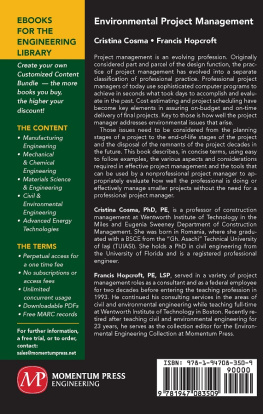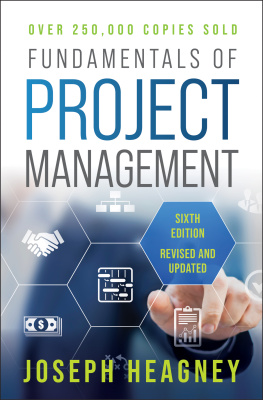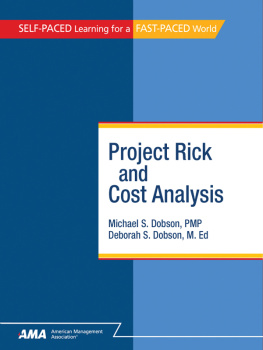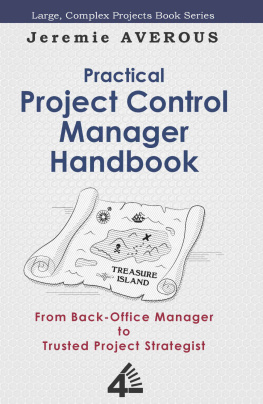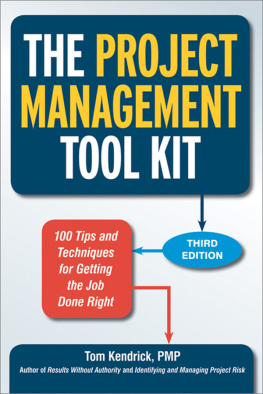Cover
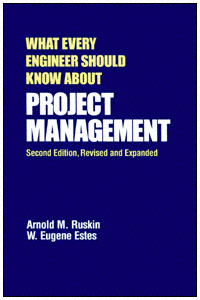
| title | : | What Every Engineer Should Know About Project Management What Every Engineer Should Know ; V. 33 |
| author | : | Ruskin, Arnold M.; Estes, W. Eugene |
| publisher | : | CRC Press |
| isbn10 | asin | : | 0824789539 |
| print isbn13 | : | 9780824789534 |
| ebook isbn13 | : | 9780585384351 |
| language | : | English |
| subject | Engineering--Management. |
| publication date | : | 1995 |
| lcc | : | TA190.R87 1994eb |
| ddc | : | 658.4/04 |
| subject | : | Engineering--Management. |
Page a
WHAT EVERY ENGINEER SHOULD KNOW ABOUT PROJECT MANAGEMENT
Page b
WHAT EVERY ENGINEER SHOULD KNOW
A Series
Editor
William H. Middendorf
Department of Electrical and Computer Engineering
University of Cincinnati
Cincinnati, Ohio
1. What Every Engineer Should Know About Patents, William G. Konold, Bruce Tittel, Donald F. Frei, and David S. Stallard
2. What Every Engineer Should Know About Product Liability, James F. Thorpe and William H. Middendorf
3. What Every Engineer Should Know About Microcomputers: Hardware/Software Design, A Step-by-Step Example, William S. Bennett and Carl F. Evert, Jr.
4. What Every Engineer Should Know About Economic Decision Analysis, Dean S. Shupe
5. What Every Engineer Should Know About Human Resources Management, Desmond D. Martin and Richard L. Shell
6. What Every Engineer Should Know About Manufacturing Cost Estimating, Eric M. Malstrom
7. What Every Engineer Should Know About Inventing, William H. Middendorf
8. What Every Engineer Should Know About Technology Transfer and Innovation, Louis N. Mogavero and Robert S. Shane
9. What Every Engineer Should Know About Project Management, Arnold M. Ruskin and W. Eugene Estes
10. What Every Engineer Should Know About Computer-Aided Design and Computer-Aided Manufacturing: The CAD/CAM Revolution, John K. Krouse
11. What Every Engineer Should Know About Robots, Maurice I. Zeldman
12. What Every Engineer Should Know About Microcomputer Systems Design and Debugging, Bill Wray and Bill Crawford
13. What Every Engineer Should Know About Engineering Information Resources, Margaret T. Schenk and James K. Webster
14. What Every Engineer Should Know About Microcomputer Program Design, Keith R. Wehmeyer
15. What Every Engineer Should Know About Computer Modeling and Simulation, Don M. Ingels
Page c
16. What Every Engineer Should Know About Engineering Workstations, Justin E. Harlow III
17. What Every Engineer Should Know About Practical CAD/CAM Applications, John Stark
18. What Every Engineer Should Know About Threaded Fasteners: Materials and Design, Alexander Blake
19. What Every Engineer Should Know About Data Communications, Carl Stephen Clifton
20. What Every Engineer Should Know About Material and Component Failure, Failure Analysis, and Litigation, Lawrence E. Murr
21. What Every Engineer Should Know About Corrosion, Philip Schweitzer
22. What Every Engineer Should Know About Lasers, D. C. Winburn
23. What Every Engineer Should Know About Finite Element Analysis, edited by John R. Brauer
24. What Every Engineer Should Know About Patents: Second Edition, William G. Konold, Bruce Tittel, Donald F. Frei, and David S. Stallard
25. What Every Engineer Should Know About Electronic Communications Systems, L. R. McKay
26. What Every Engineer Should Know About Quality Control, Thomas Pyzdek
27. What Every Engineer Should Know About Microcomputers: Hardware/Software Design, A Step-by-Step Example. Second Edition, Revised and Expanded, William S. Bennett, Carl F. Evert, and Leslie C. Lander
28. What Every Engineer Should Know About Ceramics, Solomon Musikant
29. What Every Engineer Should Know About Developing Plastics Products, Bruce C. Wendle
30. What Every Engineer Should Know About Reliability and Risk Analysis, M. Modarres
31. What Every Engineer Should Know About Finite Element Analysis: Second Edition, Revised and Expanded, edited by John R. Brauer
32. What Every Engineer Should Know About Accounting and Finance, Jae K. Shim and Norman Henteleff
33. What Every Engineer Should Know About Project Management: Second Edition, Revised and Expanded, Arnold M. Ruskin and W. Eugene Estes
ADDITIONAL VOLUMES IN PREPARATION
Page i
WHAT EVERY ENGINEER SHOULD KNOW ABOUT PROJECT MANAGEMENT
Second Edition, Revised and Expanded
Arnold M. Ruskin
Partner
Claremont Consulting Group
La Caada, California
W. Eugene Estes
Consulting Civil Engineer
Westlake Village, California

Page ii
Library of Congress Cataloging-in-Publication Data
Ruskin, Arnold M.
What every engineer should know about project management / Arold
M. Ruskin, W. Eugene Estes.--2nd Ed., rev. and expanded.
pm cm. -- (What every engineer should know ; 33)
Includes bibliographical references and index.
ISBN 0-8247-8953-9 (acid-free paper)
1. Engineering--Management. I. Estes, W. Eugene
II. Title. III. Series
TA190.R87 1994 94-39689
658.404--dc20 CIP
The publisher offers discounts on this book when ordered in bulk quantities. For more information, write to Special Sales/Professional Marketing at the address below.
This book is printed on acid-free paper.
Copyright 1995 by MARCEL DEKKER, INC. All Rights Reserved.
Neither this book nor any part may be reproduced or transmitted in any form or by any means, electronic or mechanical, including photocopying, microfilming, and recording, or by any information storage and retrieval system, without permission in writing from the publisher.
MARCEL DEKKER, INC.
270 Madison Avenue, New York, New York 10016
Current printing (last digit):
10 9 8 7
PRINTED IN THE UNITED STATES OF AMERICA
Page iii
Preface to the Second Edition
Project management has evolved at a pace that we could hardly imagine when we wrote the first edition. Both software engineers and system engineers have influenced project management considerably as they have brought their particular insights and approaches to projects. Prominent among their contributions are improvements in requirements specification, work breakdown structures, project control, and risk management. This second edition was motivated primarily by the need to describe these advances to our readers.
Having decided to prepare a second edition, we also took the opportunity to fine-tune the rest of the book. We have adjusted the discussions of the anatomy of a project, the roles and responsibilities of the project manager, and negotiating, and we have added new material on motivation, matrix arrangements, and project records. While matrix arrangements are not yet ubiquitous, they are becoming so common that every engineer should know how to operate in a matrix situation.
Next page

